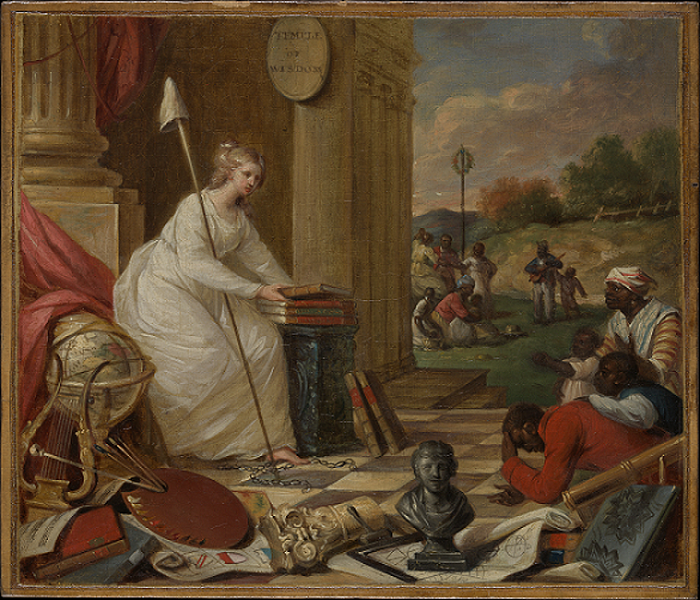Background
In the Federal period, artists continued the tradition of using female figures to symbolize a new nation. However, early U.S. artists changed their depiction of America to match the changing times. America was no longer shown as a woman wearing ancient Greek, Roman, or Indigenous clothing. Instead, she was depicted as a beautiful white woman dressed in the latest fashions. The new look indicated that the country had left the past behind and was a modern and civilized place.
About the Image
In this image, the artist depicted America as a white woman dressed in all-white, modern fashions. She is surrounded by objects that suggest she is very educated. She holds a liberty cap on a pole, a reference to the American Revolution that had only recently ended.
The figure of America is offering her wisdom, in the form of a book, to a group of Black people. The Black people all bow before her, indicating that they see her as superior. In the background, another group of Black people dances around a liberty pole, yet another symbol of the American Revolution. The artist is implying that America will share the knowledge gained from the American Revolution to help enslaved Black people gain their freedom. The idea that white people were the gatekeepers of the knowledge Black people needed to be free was common in early America. It ignored the reality that white people enslaved Black people and refused to free them.
Vocabulary
- Federal period: The early years of the United States, usually defined as 1790–1830.
- gatekeeper: Someone who controls the movement of people or information.
- liberty cap: A popular symbol used by Patriots during the American Revolution.
- liberty pole: A popular symbol used by Patriots during the American Revolution.
Discussion Questions
- Why did the artist choose to depict America as a white woman in all-white clothing?
- What message does this image of America send to the world?
- What are the problems with depicting a country as a single person?
Suggested Activities
- Use resources provided by the New-York Historical Society to trace the evolution of the symbol of America over the centuries, and then challenge students to draw a symbolic representation of the United States today. What figure would they choose? What symbols would they include?
- Connect this image with the rise of the idea of republican motherhood for a larger conversation about the new nation’s ideals surrounding womanhood.
- Contrast this image with the life stories of Oney Judge, Sukey, and Sally Hemings to help students better understand the realities facing enslaved people in the new nation.
Themes
AMERICAN CULTURE







